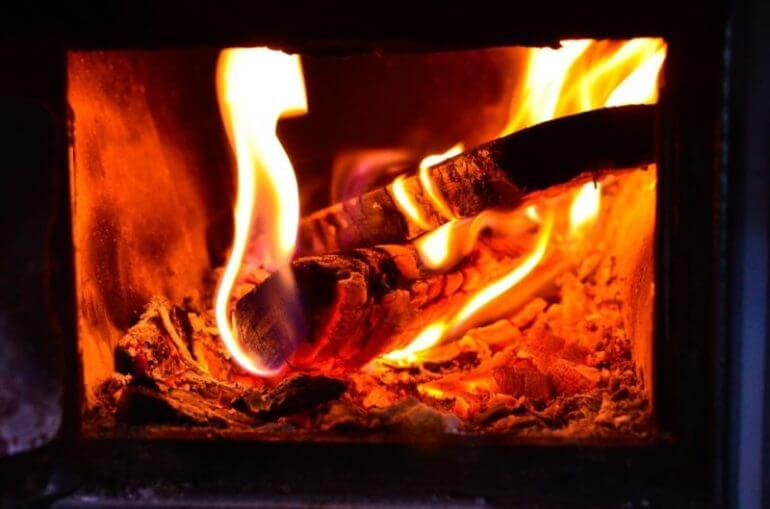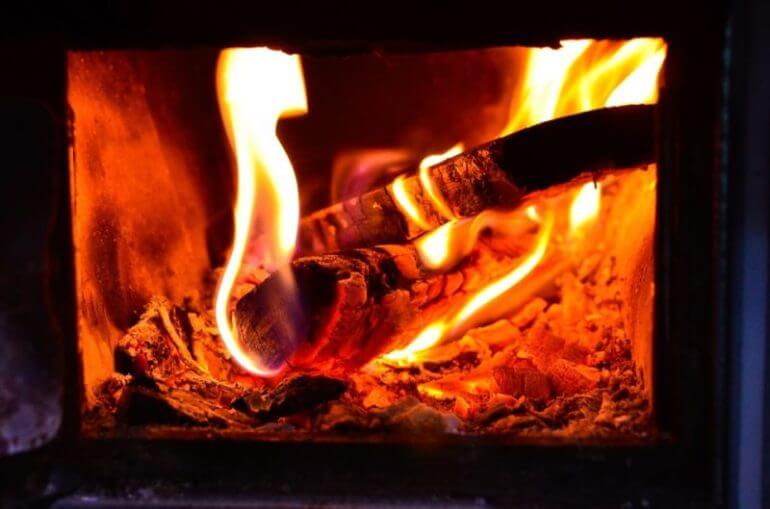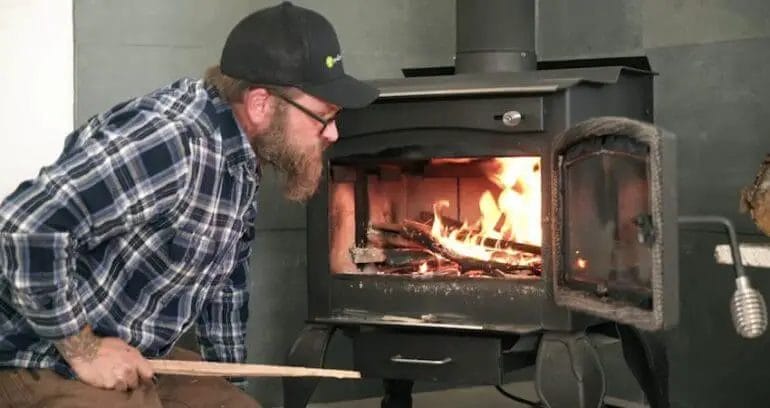A wood burning stove is a great addition to your home, providing warmth and ambiance during the colder months. Operating a wood burning stove may seem intimidating at first, but with a few simple steps, you can easily enjoy the benefits of this cozy heat source.
First, ensure that your wood burning stove is properly installed and meets all safety regulations. This includes having a proper chimney or flue system in place to vent the smoke.

When starting a fire, use dry and seasoned hardwood, such as oak or maple, as it burns cleaner and produces more heat. Begin by placing some kindling, such as newspaper or small twigs, in the stove’s firebox.
Next, open the stove’s air vents to allow for proper airflow. This will help the fire to ignite and burn efficiently. Light the kindling using matches or a lighter, and gradually add larger pieces of wood as the fire grows.
Once the fire is established, adjust the air vents to control the burn rate and heat output. Keep in mind that a slow, steady burn is more efficient and produces less smoke. Regularly add wood to maintain a consistent temperature and ensure a continuous heat source.
Remember to regularly clean and maintain your wood burning stove to keep it operating efficiently. This includes removing ashes and soot buildup, as well as inspecting the chimney or flue system for any blockages or damage.

Choosing the right wood for your stove
When it comes to heating your home with a wood-burning stove, choosing the right wood is essential. The type and quality of wood you burn can greatly affect the efficiency and performance of your stove. In this section, we will discuss the factors to consider when selecting wood for your stove, as well as the different types of wood that are commonly used.
Factors to consider
Before you start burning wood in your stove, there are a few important factors to consider:
- Moisture content: The moisture content of the wood is crucial for efficient burning. Freshly cut or green wood contains a high amount of moisture, which can result in poor combustion and a buildup of creosote in your chimney. It is recommended to use seasoned wood with a moisture content of around 20% or less.
- Density: The density of the wood determines how long it will burn and how much heat it will produce. Hardwoods such as oak and maple are denser than softwoods like pine and spruce, and therefore burn longer and provide more heat.
- Ash content: Wood with a high ash content can lead to more frequent cleaning of your stove and chimney. Hardwoods generally have a lower ash content compared to softwoods.
- Availability: Consider the availability of different wood types in your area. It is important to choose wood that is both suitable for your stove and easily accessible.
Types of wood for stoves
There are various types of wood that are commonly used for stoves. Here are some popular options:
| Wood Type | Description |
|---|---|
| Oak | Oak is a hardwood that burns slowly and provides a high heat output. It is known for its long-lasting burn and is a popular choice for heating. |
| Maple | Maple is another hardwood that produces a steady, long-lasting fire. It is known for its pleasant aroma when burned. |
| Birch | Birch is a hardwood that burns quickly and provides a good amount of heat. It is easily available and is often used as a starter wood. |
| Pine | Pine is a softwood that burns quickly and produces a strong, crackling flame. It is best used in combination with hardwoods for a longer burn. |
| Spruce | Spruce is another softwood that burns quickly. It is commonly used for kindling due to its easy ignition properties. |
It is important to note that different wood species may have variations in heat output and burning characteristics. It is advisable to research and experiment with different types of wood to find the best option for your stove.
Proper wood storage and preparation
To ensure that your wood burns efficiently and safely, proper storage and preparation are essential. Here are some tips:
- Store your wood in a dry, well-ventilated area to allow it to season properly.
- Stack the wood off the ground to prevent moisture absorption from the soil.
- Split and stack the wood with enough space between the logs for proper air circulation.
- Allow the wood to season for at least 6-12 months to reduce moisture content.
- Use a moisture meter to check the moisture content of the wood before burning.
By following these guidelines, you can ensure that the wood you burn in your stove is properly seasoned and ready for efficient combustion.
Summary
Choosing the right wood for your stove is crucial for optimal performance and efficiency. Factors such as moisture content, density, ash content, and availability should be considered when selecting wood. Oak, maple, birch, pine, and spruce are common types of wood used for stoves, each with its own burning characteristics. Proper wood storage and preparation are also important to ensure efficient and safe burning. By following these guidelines, you can enjoy a warm and cozy home throughout the winter season.

Proper Ventilation and Airflow for Optimal Wood Burning
When it comes to wood burning, proper ventilation and airflow are essential factors that greatly impact the efficiency and effectiveness of the process. In order to achieve optimal wood burning results, it is crucial to ensure that your setup allows for adequate air circulation and proper ventilation. This not only helps in achieving a cleaner burn, but also increases the heat output and reduces the amount of smoke produced.
The Importance of Ventilation
Ventilation plays a critical role in wood burning as it allows for the proper exchange of air within the burning chamber. Sufficient airflow helps in maintaining a steady combustion process and prevents the buildup of harmful gases such as carbon monoxide. Without adequate ventilation, incomplete burning can occur, leading to the production of excessive smoke and pollutants, which is not only detrimental to your health but also harmful to the environment.
In order to ensure proper ventilation, it is important to have a well-designed and properly installed chimney or flue system. This allows for the expulsion of smoke and toxic fumes out of your living space. Additionally, having adjustable air vents or dampers on your wood-burning appliance enables you to control the amount of air that enters the firebox, thus regulating the combustion process and maintaining optimal burning conditions.
Achieving Optimal Airflow
In addition to ventilation, creating an environment that promotes optimal airflow is equally important. Adequate airflow helps in providing the necessary oxygen for the fire to burn efficiently and effectively. Insufficient airflow can result in a weak and smoldering fire, whereas excessive airflow can lead to a rapid burn and inefficient use of fuel.
One way to ensure proper airflow is by arranging the wood pieces in a way that allows for sufficient gaps between them. This promotes the circulation of air around the fire, enabling it to burn more efficiently. It is recommended to use a log grate or similar device that elevates the wood off the bottom of the firebox, allowing for air to reach the fire from below.
Additionally, maintaining a clean and unobstructed chimney or flue system is crucial for optimal airflow. Regular inspection and cleaning of the chimney to remove any creosote buildup or debris can help in ensuring smooth airflow and preventing any potential blockages. This not only improves the efficiency of the wood-burning process but also reduces the risk of chimney fires.
Tips for Maximizing Efficiency
Here are some additional tips to maximize the efficiency of your wood-burning setup:
- Use seasoned firewood that has been properly dried for at least 6-12 months. Moisture content in the wood significantly affects burn efficiency and the amount of smoke produced.
- Avoid burning wet or green wood as it not only produces less heat but also creates excessive smoke and creosote buildup.
- Regularly clean ashes from the firebox to maintain proper airflow and prevent any obstructions.
- Consider using airtight wood-burning appliances or inserts that are designed to maximize heat output and burn efficiency.
- Install carbon monoxide detectors in your living space to ensure the safety of you and your family.
Summary
Proper ventilation and airflow are crucial for achieving optimal wood burning results. With adequate ventilation, harmful gases can be safely expelled, while optimal airflow ensures efficient and effective combustion. By following the tips mentioned above and maintaining a well-designed wood-burning setup, you can enjoy a cleaner burn, increased heat output, and reduced environmental impact.

How to Start and Maintain a Fire in Your Wood Burning Stove
Having a wood burning stove in your home can provide a cozy and warm atmosphere during the winter months. However, knowing how to properly start and maintain a fire is essential to ensure efficient heating and safety. In this section, we will guide you through the steps to start a fire in your wood burning stove and provide tips on how to maintain it.
Gather the Necessary Supplies
Before starting a fire, make sure you have all the necessary supplies ready. These include:
- Firewood: Choose dry and seasoned hardwood, such as oak or maple, which burn longer and produce more heat.
- Kindling: Small sticks, newspaper, or fire starters can be used to ignite the firewood.
- Tinder: Easily ignitable material, such as dry leaves or small twigs, helps start the initial flame.
- Fireplace tools: Keep tools like tongs, a poker, and a shovel nearby for adjusting the fire and removing ash.
Prepare the Wood Burning Stove
Ensure that your wood burning stove is clean and free of any debris. Remove the ashes from the previous fire and open the damper or air vents to allow proper airflow. Check that the flue is open and not obstructed.
Build the Fire
Here’s a step-by-step process to build a fire in your wood burning stove:
- Place tinder in the center of the firebox. Crumpled newspaper or dry leaves work well as tinder.
- Arrange kindling in a crisscross pattern on top of the tinder. Make sure there is enough space for airflow.
- Add a few small pieces of firewood on the top of the kindling, leaving gaps between the logs for air circulation.
- Light the tinder using a match or a long-reach lighter. Avoid using flammable liquids.
- Gradually add additional firewood as the fire grows. Close the stove door, but leave it slightly ajar to allow sufficient oxygen supply.
Maintain the Fire
Once the fire is burning, it’s important to maintain it properly for optimal heat production and safety. Here are some tips:
- Remove ashes: Regularly remove ashes from the firebox to prevent airflow obstructions. Leave a thin layer of ash, as it acts as insulation and aids in combustion.
- Add firewood: Add firewood as needed to maintain a consistent flame. Avoid overloading the stove, as it can lead to poor combustion and excessive smoke.
- Control airflow: Adjust the damper or air vents to control the airflow and regulate the temperature. More air increases the heat, while less air slows down the burn.
- Keep a safety distance: Maintain a safe distance between flammable objects and the wood burning stove to prevent accidental fires. Use a fireplace screen for additional safety.
- Monitor the fire: Regularly check the fire to ensure it’s burning steadily and evenly. Make adjustments if necessary.
In Summary
Starting and maintaining a fire in your wood burning stove requires proper preparation and attention. Gather the necessary supplies, prepare the stove, build the fire with tinder, kindling, and firewood, and maintain it by adjusting airflow and removing ashes. Remember to prioritize safety by keeping a safe distance from flammables and monitoring the fire regularly. Stay warm and cozy throughout the winter with a well-maintained wood burning stove.
Cleaning and Maintenance Tips for Your Wood Burning Stove
A wood burning stove can be a wonderful addition to your home, providing warmth and ambiance during the colder months. To ensure that your wood burning stove continues to operate efficiently and safely, it is important to regularly clean and maintain it. Here are some helpful tips to keep your wood burning stove in top condition:
1. Empty the Ash Pan Regularly
Wood burning stoves produce ashes as a byproduct of the combustion process. Over time, these ashes can accumulate in the ash pan, reducing the stove’s efficiency. To prevent this, it is essential to empty the ash pan regularly. Wait for the ash to cool down completely before removing it from the stove. Dispose of the ashes in a metal container, as they can remain hot for several hours.
2. Clean the Glass Door
The glass door of your wood burning stove can become dirty and cloudy over time due to the buildup of soot and smoke residues. To maintain a clear view of the fire, regularly clean the glass door using a specialized stove glass cleaner. Apply the cleaner onto a soft cloth and gently rub the glass in circular motions. Avoid using abrasive materials that could scratch the glass.
3. Check and Clean the Flue
The flue is an essential component of the wood burning stove as it expels the combustion byproducts and harmful gases. Inspect the flue regularly to ensure it is free from any obstructions such as bird nests or debris. If necessary, use a chimney brush or seek professional help to clean the flue thoroughly. A clean flue promotes better airflow and prevents the risk of chimney fires.
4. Maintain the Firebricks and Baffle
Firebricks and baffles help to protect the stove’s interior from extreme heat and prolong its lifespan. Inspect the firebricks and baffle regularly for any cracks or damage. If any are found, replace them promptly to maintain the stove’s efficiency and safety. Consult the manufacturer’s guidelines for the correct type and installation of firebricks and baffles.
5. Schedule Professional Maintenance
While regular cleaning and maintenance are essential, it is also recommended to schedule professional maintenance for your wood burning stove at least once a year. A professional technician can inspect the stove thoroughly, clean and adjust components, and identify any potential issues that may require repair.
In summary, keeping your wood burning stove clean and well-maintained is crucial for its optimal performance and safety. By following these tips, you can enjoy the warmth and comfort of your wood burning stove for years to come.
FAQs
1. How do I operate a wood burning stove?
To operate a wood burning stove, start by opening the air vents to allow oxygen for combustion. Place dry and seasoned firewood in the stove, leaving enough space for air circulation. Ignite the fire using kindling or fire starters, and gradually add larger logs. Control the temperature by adjusting the air vents and ensure regular cleaning and maintenance for safe and efficient operation.
2. What type of wood should I use in a wood burning stove?
For optimal performance, use well-seasoned hardwood like oak, maple, or birch in a wood burning stove. Avoid using softwoods like pine or spruce as they contain more resin, which can lead to more creosote buildup in the chimney and potentially cause chimney fires.
3. How often should I clean my wood burning stove?
Regular cleaning is essential for safe and efficient operation of a wood burning stove. It is recommended to clean the stove and chimney at least once a year, preferably before the start of the heating season. However, if you notice excessive creosote buildup or experience any drafting issues, it is advisable to clean the stove more frequently.
Conclusion
In conclusion, operating a wood burning stove requires proper knowledge and attention to ensure both efficiency and safety. By following the guidelines provided by the manufacturer, you can effectively manage the temperature and airflow to maximize heat output. Regular cleaning and maintenance are vital to prevent creosote buildup and ensure optimal performance. Additionally, using seasoned firewood and practicing responsible burning habits can minimize environmental impact and reduce air pollution. Remember to always prioritize safety measures, such as using protective gloves and keeping flammable objects at a safe distance from the stove. With the right approach, operating a wood burning stove can bring warmth and comfort to your home while minimizing energy costs.
